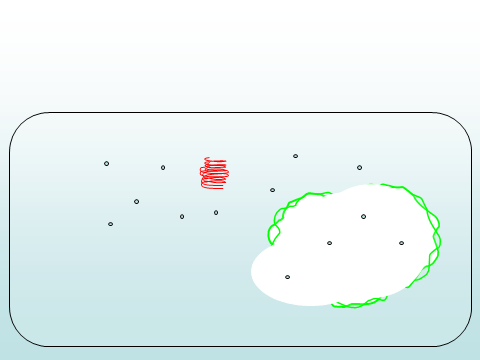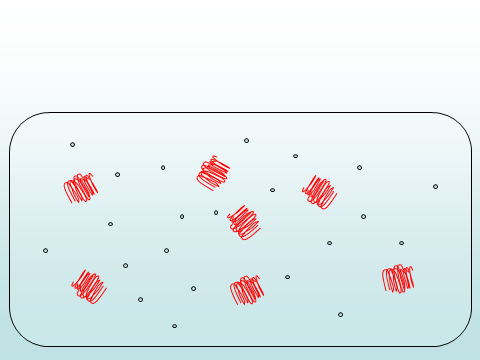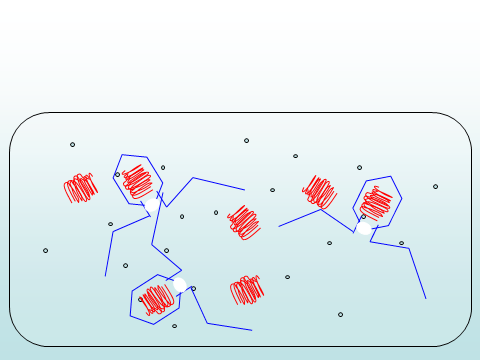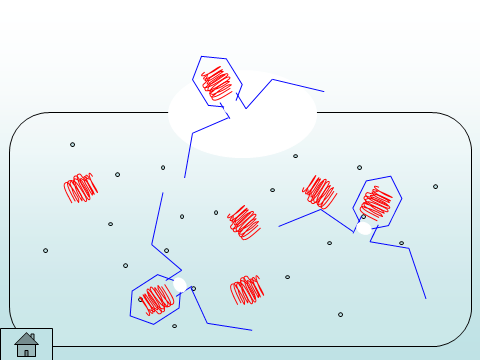Life forms: non-cellular and cellular.
Living organisms that exist on Earth, for the most part, have a cellular structure. At the same time, there are others, noncellular life forms - viruses and bacteriophages.
Non-cellular life forms.
Viruses are much smaller than prokaryotes (20-300 nm) and are distinguishable only under an electron microscope. They lack cellular structure, metabolism and energy. Viral particles contain only one type of nucleic acid - RNA (one or two strands) or DNA (single or double stranded linear). Viruses are not able to synthesize proteins on their own, since they have ribosomes, and do not grow. The way viruses reproduce differs significantly from that of other organisms.
The viral model of cellular origin reflects Haldane's early ideas at a completely different stage in the development of biology. The current support and indeed the incentive for this model stems from four lines of significant comparative genomic evidence.
Thus, it seems that there is a continuity between the hypothetical, primary viral stage of life evolution and the dynamic prokaryotic world, the main difference of which is the additional compartmentalization caused by cellular organization and ensuring the preservation of large genomes.
More than 3,000 viruses are known to infect tissue cells of plants, animals and humans. In nature, they are ubiquitous.
Cellular life forms.
Cellular life forms are represented by prokaryotes and eukaryotes.
Prokaryotes (prenuclear organisms) have sizes from 1 to 5 microns, the simplest type of cell structure:
In addition to being compatible with multiple lines of empirical evidence, the viral model of early evolution appears to offer at least a preliminary solution to the classic Darwinian problem of the evolution of complex structures that can only function as a unit, in this case the cell itself. This decision occurs along the lines first described by Darwin himself, that is, the gradual evolution of a complex organization through intermediaries whose functions differ from, even if they are mechanically similar to those that are fully developed.
No formalized core;
One circular DNA molecule;
The system of internal membranes is poorly developed, there are no membrane organelles (endoplasmic reticulum, mitochondria, Golgi complex, lysosomes, centrioles);
There are ribosomes;
The functions of membrane organelles are performed mesosomes.
Cell division is carried out by constriction, without the formation of a division spindle;
This model assumes that primordial functions develop as part of the life cycles of virus-like genetic elements. The world's primary virus model, at least in part, can be refutable and possibly testable. The discovery of an organism with an archaeal replication system, but the bacterial membrane would come close to refutation. Such evidence will support the role of viruses in the evolution of cell membranes. Direct biochemical experiments on early evolution are inherently complex.
However, this model can facilitate them by dividing the Gargantuan feat of cell evolution into more manageable steps in the evolution of virus-like agents. Valerian Dolya, Bill Martin, Tanya Senkevich, and Yuri Volk contributed to the development of various aspects of this model. This work was supported by the National Institutes of Health Research Program of the National Medical Library.
The cell wall consists of a glycoprotein - mureina.
Prokaryotes are represented by bacteria and cyania. This is the most ancient group of representatives of the organic world: the age of the rocks in which their spores are found is 3.5 billion years.
Eukaryotes - ϶ᴛᴏ a group of single and multicellular organisms, whose cells, despite the variety of forms and functions performed, have a single structure plan: a nucleus delimited from the cytoplasm by a nuclear membrane: a well-developed network of intracellular membranes (all organelles of a membrane structure are present); cell division mitosis, meiosis, amitosis; plants and fungi have a cell wall. Sizes from 13 microns to 10-20 cm and more. Includes three groups of organisms: plants, fungi, animals.
The Impact of Comparative Genomics on Our Understanding of Evolution. Molecular evolution is in line with the genomics revolution. Evolutionary aspects of the biology of the whole genome. Comparative genomics, minimal gene sets, and the last universal common ancestor.
The last universal common ancestor: the genesis, constitution, and genetic heritage of an elusive predecessor. Genomes in flux: evolution of the content of archaea and proteobacterial genes. Algorithms for calculating the calculated evolutionary scenarios for the evolution of the genome, the last universal common ancestor and the dominance of horizontal gene transfer in the evolution of prokaryotes.
| Sign | Plants | Mushrooms | Animals |
| Food type | Primary autotrophs, but there are secondary heterotrophs (sundew, Venus flytrap) | Heterotrophs (saprophytes) | heterotrophs |
| Carbohydrate storage | starch | Glycogen | glycogen |
| Lifestyle | Usually attached, but can be mobile | Attached | As a rule, free-living, but there are attached (adult ascidians, coral polyps). |
| Cell wall | Mainly cellulose, less chitin | Mainly from chitin, less often from cellulose | No |
| Response to annoyance | Tropisms and Nastias | Taxis, reflex | |
| Height | Not limited | Not limited | Limited by genotype |
Life forms: non-cellular and cellular. - concept and types. Classification and features of the category "Life forms: non-cellular and cellular." 2014, 2015.
“Non-cellular life forms” Biology lesson in grade 11 using presentation in part-time classrooms
The difference is homologous to similar proteins. The minimum estimate of the gene content of the last universal common ancestor is ecbiology from an earthly point of view. The smallest gene identified for cell life, obtained by comparing complete bacterial genomes.
On the origin of cells: a hypothesis of evolutionary transitions from abiotic geochemistry to chemoautotrophic prokaryotes and from prokaryotes to germ cells. Biosynthesis of lipid animals and early evolution of membranes. Molecular search for the last common ancestor. Evolutionary relationship of archaea, eubacteria, and eukaryotes derived from duplicated gene phylogenetic trees.
Lesson objectives:
Educational: to expand and deepen students' knowledge about viruses, structural features and life.
Developing: develop information competence.
Educational: to form the concept of a healthy lifestyle.
Lesson type: learning new material, primary consolidation of knowledge.
Equipment: textbook, articles, additional literature, presentation, programmed card, self-test card.
The root of the tree of life in the light of the covariance model. Rooting the universal tree of life is not reliable. Protein evolution trends are inferred from sequence and structure analysis. The nature of the last universal ancestor and the root of the tree of life are still open questions.
The last universal common ancestor, simple or complex? Non-cellular life is life that exists without a cellular structure. Until the 21st century, people generally accepted that in order to be considered a form of life, an organism had to have a cell, although the structure of cells could vary considerably. This excluded things like viruses from the list of "living" organisms. Additional research, however, has suggested that this classification may be misleading and that things like viruses may indeed be considered life forms.
New concepts: virus, virion, virology, bacteriophage, retrovirus.
During the classes
Knowledge update.
Today in the lesson, we must consider the amazing biological systems that cause a lot of negative emotions. Descriptions of the activities of these biological objects can be found in the poems of the Japanese Empress Koken in the 8th century.
This gave rise to the term "non-cellular life" to describe such organisms, differentiating them from cellular life, such as bacteria, protists, animals and plants. The ability to synthesize proteins is considered a major factor in determining whether an organism is alive or not, and most viruses must invade cells to make proteins.
Given the large number of as yet undiscovered viruses in the world, it is entirely possible that researchers may one day find more viruses capable of producing proteins. This suggests that viruses may have evolved from earlier life forms that are capable of producing proteins independently of the cell. He also broadens his horizons considerably when he ponders; if non-cellular life exists on Earth, it can be found elsewhere.
Tell me maybe
In this village
Did the frost fall endlessly all the time?
Grass. What I saw in the summer
Crimson - scarlet became in the fields!
Until now, there is a dispute about whether these objects should be attributed to living or inanimate nature. If we translate their name from Latin, then we get the word - poison! You probably guessed that today we will talk about ... (students' answers) (slide 1)
In addition to viruses, structures such as cosmids, satellites, viriodes, phosmids, prions, phagemids can also be considered non-cellular life. Recognizing viruses as a legitimate life form can also deepen human understanding of these fascinating and complex organisms. Like cellular life forms, viruses clearly have their own plans and life goals, although these goals can sometimes conflict with the interests of humans, animals and plants. The fact that some viruses are capable of producing proteins can also be a factor in the treatment of some viral infections, as drugs can be developed to target these proteins and kill the virus.
Do you think that knowledge about viruses can be useful in our life? (student answers)
Formulate the purpose and objectives of today's lesson (student responses) (slide 2)
Get to know the work plan in the lesson (slide 3)
2. Learning new material
Before you get down to work, a few words to the outstanding Russian scientist Dmitry, Ivanovsky, who, studying plant diseases, tobacco discovered the smallest organisms
Introduction: signaling molecules and cellular receptors
Cellular communication provides regulation of biological processes in various environments from unicellular and multicellular organisms. Explain the importance of cellular communications. The ability of cells to communicate by means of chemical signals occurred in individual cells and was necessary for the evolution of multicellular organisms. In multicellular organisms, cells constantly send and receive chemical messages to coordinate the actions of distant organs, tissues, and cells. Cells can receive a message, transmit information across the plasma membrane, and then make changes within the cell in response to the message. Single-celled organisms such as yeast and bacteria communicate with each other to aid in mating and coordination. Cellular communication has evolved as a means of communicating with the environment, producing biological changes, and, if necessary, ensuring survival. Biofilm: A thin film of mucus created by and containing a colony of bacteria and other microorganisms. Imagine what life would be like if you and the people around you could not communicate.
viruses, (slide 4.5). Look, viruses look so beautiful on illustrations and electronic photos (slide 6,7,8). Viruses cause many dangerous infectious diseases, (slide 9) but one thing can threaten, everyone and there are no drugs. Our city was not spared this misfortune (slide 10). What is this disease? (slide 11-14).
You could not express your wishes to others, and you could not ask questions to learn more about your environment. Social organization depends on communication between the people who make up this society; without communication, society will fall apart. Communication is key: have you ever been separated from a friend in a crowd? If so, you know the challenge of finding someone when they are surrounded by thousands of others. If you and your friend have cell phones, your chances of finding each other are good. The cell phone's ability to send and receive messages makes it an ideal communication device.
But you can protect yourself and your loved ones, (slide 15)
Now everyone gets a programmed map and literature. The answers can be written on the sheet - they remain with you. When you finish, you can check your work on the self-test card, if the task is not answered, then this task remains at home.
Then the students proceed with the assignments and the subsequent self-assessment
As with humans, it is vital that individual cells can interact with their environment. This is true if the cell grows by itself in a pond or is one of many cells that form a larger organism. To properly respond to external stimuli, cells have developed sophisticated communication mechanisms that can receive a message, transmit information across the plasma membrane, and then make changes within the cell in response to the message.
The ability to send messages quickly and efficiently allows cells to coordinate and fine-tune their functions. While the need for cellular communication in larger organisms seems obvious, even single-celled organisms communicate with each other. Yeast cells signal each other to aid mating. Some forms of bacteria coordinate their actions to form large complexes called biofilms, or to organize the production of toxins to remove competing organisms.
3. Consolidation of knowledge bluff club. Students are offered statements on the topic studied, with which they can either agree or disagree. After thinking through the chain, students give a yes or no answer with a short explanation.
1. The size of viruses is several times larger than the size of bacteria
2. Our Russian scientist Ivanovsky is rightfully considered the godfather of virology.
The efficient and error-free function of communication systems is vital to all forms of life. The main types of signaling mechanisms that are found in multicellular organisms are paracrine, endocrine, autocrine and direct signaling. Describe the four types of signals found in multicellular organisms.
In multicellular organisms, there are four categories of chemical signaling: paracrine signaling, endocrine signaling, autocrine signaling, and direct signaling through gap junctions. The main difference between the different categories of signaling is the distance the signal travels through the body to reach the target cell. It is also important to note that not all cells are affected by the same signals.
3. Viruses cannot be called a living organism.
4. Unlike bacteria, viruses contain nucleic acids in a formed nucleus.
5. In viruses, DNA carries hereditary information.
6. Viruses and virions are different types microorganisms.
7. A virus is bad news in a protein coat.
8. Viruses are characterized by the processes of growth, division, metabolism and energy.
Forms of chemical signaling: In chemical signaling, a cell can target itself, a gap junction cell, a neighboring cell, or a distant cell. Paracrine signaling acts on neighboring cells, endocrine signaling uses the circulatory system to carry ligands, and autocrine signaling acts on a signaling cell. Gap junction signaling involves signaling molecules moving directly between adjacent cells.
Signals that act locally between neighboring cells are called paracrine signals. Paracrine signals move by diffusion through the extracellular matrix. These types of signals usually elicit quick responses that last only a short time. To maintain a localized response, paracrine ligand molecules are usually rapidly degraded by enzymes or removed by neighboring cells. Removing the signals will restore the signal concentration gradient, allowing them to quickly diffuse through the intracellular space if released again.
9. The assembly of viruses takes place in the external environment, and not in the affected cells.
10. Bacteriophages are types of bacteria
11. Viral infections - flu, tuberculosis, hepatitis, AIDS.
12. HIV and AIDS are different concepts.
13. AIDS can be contracted by shaking hands, sharing utensils.
So, let's get back to the purpose and objectives of our lesson (file 1). What have you learned new? (students' answers). Raise your hands - who completed all the tasks! Who handled the bluff club's claims? Well done! Who made one or two mistakes? This is a good result! Well, whoever did not find all the answers or made mistakes - do not be discouraged, you have victories ahead of you.
4. home assignment: compose a synquake on the topic.
At the end of the lesson, I would like to acquaint you with the parable of the sage and the butterfly:
In ancient times there was a sage, to whom people came for advice. He helped everyone, people trusted him and greatly respected his age, life experience and wisdom. And then one day an envious man decided to dishonor a sage in the presence of many people. The envious and cunning man came up with a whole plan of how to do this: “I will catch the butterfly and bring it to the sage in my closed palms, then I will ask him what he thinks, is the butterfly alive or dead in my hands. If the sage says that she is alive, I will close my palms tightly, crush the butterfly and, opening my hands, I will say that our great sage was mistaken. If the sage says that the butterfly is dead, I will open my palms, the butterfly will fly out alive and unharmed, and I will say that our great sage was mistaken. " So did the envious person, caught the butterfly and went to the sage. When he asked the sage what kind of butterfly was in his palms, the sage replied: "Everything is in your hands."
Remember that your health and your life are in your hands. Thanks for your work.
Appendix # 1
Programmed card
1.to study the structure of the virus and answer the questions:
1) Why does the immune system of the affected organism simply not notice viruses?
3. Establish a correspondence between the picture and the stage of reproduction, (Appendix 1.) What are the differences between the reproduction of viruses from the division processes
Infected cells Viruses
B. leukocytes 2. smallpox virus
E. epithelium 5.poliomyelitis
E. nasal mucosa 6. HIV
G. hepatocytes 7. Influenza
5.Is it true that viruses can be used as medicinal product?
6. In modern media, the terms HIV and AIDS are often used interchangeably. Is this interchange possible? Explain why.
7. Why is HIV called that?
10. Based on what you have learned, list the distinguishing features of viruses. If you are at a loss, then answer the questions.
1) the size of the viruses?
5) How do viruses multiply?
Appendix # 2
Self-control knowledge
1) Why does the immune system of the affected organism simply do not notice viruses?
The fact is that many viruses form an additional membrane from the membrane of the affected cell and therefore the immune system takes viruses for its own
2)Comment on the nobel laureate Peter Medawar's statement that viruses are bad news in protein packaging.
Indeed, all viruses have a protein coat (capsid) and some even have a supercapsid.
2.write the diagram
Capsid shape
1.spiral 2.multihedral
3. A3 B4 C 2 D 5 D 1
4. establish a correspondence between the virus and the infected cells
A 4 B 6 C 5 D 1 E 2 E 7 F 3
5. Is it true that viruses can be used as a drug? (If you are at a loss, see Appendix 2.)
Yes, bacteriophages are effective remedy treating bacterial infections
6. In modern media, the terms HIV and AIDS are often used interchangeably. Is this interchange possible? Explain why.
No, since HIV is a human immunodeficiency virus (name of the pathogen), and AIDS is acquired immunodeficiency syndrome (the last stage of the disease)
7. Why was HIV called that?
Since, it affects leukocytes, in particular T-helper cells, which are responsible for the production of antibodies, the main knights of immunity.
8. Why is HIV not transmitted through household items, handshakes? (if you find it difficult - see Appendix 3.)
HIV is unstable in the environment
9. What are the main measures to prevent HIV infection?
1) avoid casual sex
2) condoms
3) disposable syringes, sterilized instruments
4) Checking donated blood and organs
7.based on what you have learned, list the distinguishing features of viruses
1.small size
2.cellular structure
3.the carrier of hereditary information is DNA or RNA
4.Lack of metabolism (do not eat food, do not generate energy, do not grow)
5.special type of breeding
Appendix 3. Reproduction of viruses
1.the exit of viruses from the cell

B. 2.copying the virus genome

C. 3.injection of the virus genome into the cell

D. 4.Disruption of the host genome

E. 5.Self-assembly of new virions
Programmed card
1. to study the structure of the virus and answer the questions: 1) Why does the immune system of the affected organism simply not notice viruses?
2) Comment on Nobel laureate Peter Medawar's comment that viruses are bad news in protein packaging.
2. What classifications, and on what grounds can you suggest regarding viruses?
3. Establish a correspondence between the picture and the stage of reproduction (Appendix 1.). Name the differences between the reproduction of viruses from the processes of division
4.Set the correspondence between the virus and the infected cells
Infected cells Viruses
A. tobacco plants 1. Bacteriophage
B. leukocytes 2. smallpox virus
B. Nerve cells 3.Hepatitis virus
D. bacteria 4.tobacco mosaic virus
E. epithelium 5.poliomyelitis
E. nasal mucosa 6. HIV
G. hepatocytes 7. Influenza
5. Is it true that viruses can be used as a drug?
6. In modern media, the terms HIV and AIDS are often used interchangeably. Is this interchange possible? Explain why.
7. Why was HIV called that?
8. why HIV is not transmitted through household items, handshakes. Remember the structure of the digestive tract.
9. What are the main measures to prevent HIV infection?
10. Based on what you have learned, list the distinguishing features of viruses. If you are at a loss, then answer the questions
1) the size of the viruses?
2) can a virus be called a cell and what does it consist of?
3) what is the carrier of hereditary information in viruses?
4) What do viruses eat, how do they grow and what is their metabolism?
5) How do viruses multiply?
